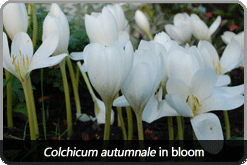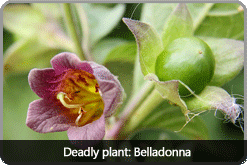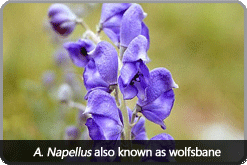Many plants might appear innocent and harmless at first glance, but there are many which produce toxins dangerous to humans and other animals.

The autumn crocus (Colchicum autumnale) is a spring and winter flowering species of plant, and when they bloom they have large flowers with no leaves – which explains their nickname naked ladies. It is a poisonous plant, and all parts have found to contain toxins, particularly the bulb which has the biggest concentration of toxin. Side effects of coming into contact with this poison can cause anything from skin allergies to death, so can be very serious. There are many documented cases of accidental death related to the autumn crocus (for example, some people have mistaken it for wild garlic and eaten it). Symptoms of poisoning by this plant will often look like those seen for arsenic poisoning, and there is no antidote for it currently, showing how toxic it really is. However, in small amounts, it has been shown to be beneficial to treat gout and rheumatism, as well as leukaemia, and is used in medicines for these conditions.

The castor oil plant, Ricinus communis, produces seeds which contain the toxin known as ricin. This toxin can be lethal to humans if ingested, and the castor oil plant is known as the most lethal plant in the world (as little as four or five seeds can provide a lethal dose), although cases involving fatalities are quite rare as the effects take a while to appear (due to the way the toxin takes effect: it stops protein being made in the body) and a full recovery can often be made with the appropriate treatment. Due to its toxicity, the plant has a natural defence against pests – because of this, ricin is under investigation to see if it has the potential to be used as an insecticide.
Belladonna, or Atropa belladonna, is a member of the Solanaceae family of plants and one of the most deadly plants in the UK. Both its berries and its leaves are highly toxic, as they contain alkaloids which have anticholinergic properties, and they can cause side effects such as hallucinations. Around 2-5 berries can kill a child whilst 10-20 can kill a fully grown adult. As with Aconitum napellus, it has often been used to make poison-tipped arrows and as a poison for assassination throughout history.


Aconitum napellus is more commonly known as 'monkshood' or 'wolfsbane'. It is a perennial plant which grows with hairless stems and rounded, hairless leaves. It contains toxic alkaloid compounds, including a cardiac poison which has been used throughout history to tip weapons to eradicate enemies. It has an unpleasant taste that means it is rare to be poisoned by accident. Aconite, a chemical produced in the roots of the plant, is used in some Chinese medicines. However, overdose due to misuse of these medicines can lead to nervous system and cardiovascular damage and even death in extreme cases.
Often used as a nematicide and an insecticide, the toxin from the marigold plant (more specifically the marsh marigold) causes damage to the nervous system as well as the digestive and respiratory systems in the larvae of many insects. This toxin is mainly found in the growing shoots of the plant and can cause irritation and blistering if it comes into contact with the skin. However, if the toxin is ingested, it can be very dangerous once digested – this often happens due to the use of the plant in herbal medicines.

